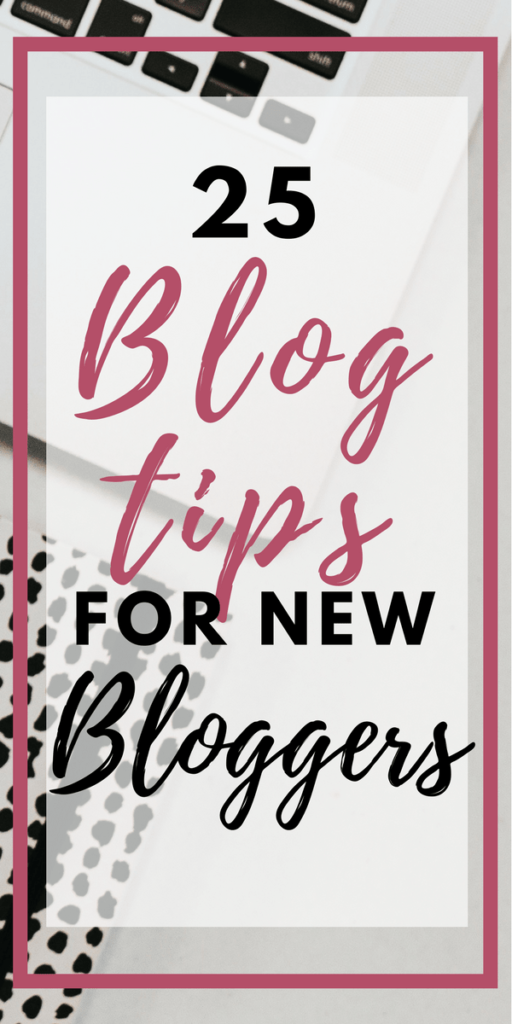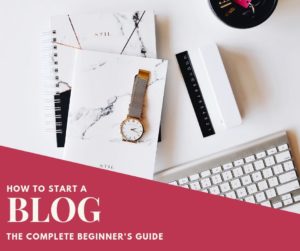25 Blog Tips For New Bloggers (Part 1)
I am an affiliate with links to an online retailer in this blog post. When you read what I have written about a particular product and click on that link and buy something from the retailer, I can earn a commission. Please note that I only recommend products that I truly believe in and use in my business. Please read my full disclaimer here
 I started working on my blog consistently in August 2017 and I’m on my eighth month of blogging (at the time of writing). Since then my traffic has grown from zero to over 10,000 page views a month, I now earn a passive income from blogging and have built an email list of over 700 lovely subscribers just from my blog.
I started working on my blog consistently in August 2017 and I’m on my eighth month of blogging (at the time of writing). Since then my traffic has grown from zero to over 10,000 page views a month, I now earn a passive income from blogging and have built an email list of over 700 lovely subscribers just from my blog.
Obviously to grow my blog I need to step it up a notch and already have my blog goals written down since the start of this year.
Some of my goals include growing my audience to over 100k pageviews a month, generate at least five figures a month and increase my subscribers to at least 2000.
There are other goals that matter such as increasing my domain and page authority but for now those are the ones at the top of the list.
In just eight months, I have learnt so much and every day I meet new people who are helping me to increase my knowledge and level up my skills.
I like to think of myself as a quick learner so based on those past eight months and the goals that I currently have, I am going to share with you 50 juicy tips (25 in this post) that helped me get to where I am. Maybe you can take away some golden nuggets from it and apply it to your own blog.
Ideally I would like to provide 50 tips but because this is a super duper long post I will split it over two posts. The second post will be posted shortly.
1. Know your limit
The number one reason why new bloggers quit is because they really don’t know what they signed up for.
Blogging takes time, consistency and determination to make any significant headway. You have to be prepared to work hard over a period of time before you start seeing any results from your efforts.
If you are going to start blogging as a business, decide the amount of time you are going to commit. If you cannot dedicate enough time, sometimes it can take 6-12 hours for 6 months or more, then I would not recommend you start a blog.
2. Get your own web hosting
When I started blogging, I started with WordPress.com. I paid about $80 for the premium version but after reading other bloggers’ posts about avoiding free blogs by using WordPress.org I quickly asked for a refund of my money and signed up to WordPress.org.
I am lucky to have done that because I dodged a serious bullet as I realised that had I built a blog on WordPress.com I would not have been able to monetise it the way I wanted and it would not have belonged to me.
I see so many people still using free blogs and I think how badly they are limiting their growth. If you want to start a blog as a business and earn money from it stop blogging on free blogs and get your own webhosting.
If you are ready to step up to the plate as a professional blogger then checkout my post The Ultimate Guide To Starting A Successful Blog.
There I teach you how to start a blog using Bluehost and WordPress.org in under an hour. It really does not take long at all and there is no tech business involved.
3. Use a professional, beautiful theme
The truth is, your blog is like your storefront. What appears to the reader the first time they click on your link determines whether they will bounce from your page or hang around for a while.
That is why once you have created a blog, you should take the time to select a beautiful theme that is attractive to the visitor.
If you don’t know whether it is attractive ask a friend. It is always a good idea to have a fresh pair of eyes who can give you another opinion.
Also, make sure that your blog is easy to navigate. A good blog has a menu at the top, which easily directs the visitor to categories that can help them get to the content that they want to read.
Make sure that your blog has a footer, which usually has all your legal info like terms and conditions, privacy policies and affiliate disclaimers.
4. Set up and build an email list
An email list is super important. Think of your email list as a community of people who look forward to hearing from you by email.
They want to know what’s going on in your business life and continue to look to you for advice. It is one of the first things that I would strongly recommend you do as you start your blogging journey or if you have already started.
You can start an email list using tools like Aweber or GetResponse. I have over 14 lists in my email service which is divided into different categories based on what people want to read.
Having an email list is also a source of free traffic. So if one day you find that a traffic source that you have been using such as Google or Facebook, suddenly goes away, you still have a list of people to “talk” to.
Related Posts:
- The Ultimate Email Marketing Strategy For Bloggers, Marketers and Beginners
- How To Build Your First Email List From Scratch
- How To Write A Welcome Email That Gets Opened Every Time
5. Use content upgrades in your blogging strategy
A content upgrade is a lead magnet or opt in freebie, that is delivered to your visitor when they opt into your lead box. It is specifically designed to be congruent with the message of a blog post.
For example, if your blog post is about “An Analysis of 1000 Facebook Ads”, your content upgrade could be “Bonus Tips For Your Next Facebook Ad”.
The content upgrade should enhance or build upon the existing content that is on the blog hence the name “content upgrade”.
Content upgrade lead boxes can be embedded within content on your blog post. Here is an example of one of my content upgrades in my blog post.
I used LeadPages to create that lead box. I wrote a detailed review of LeadPages here.
Throughout my website I have provided different content upgrades and have found that by doing so I have been able to increase my subscribers. Having multiple email lists offering different content upgrades is better as you build your email list faster.
6. Have a content calendar
It is important that you blog consistently and having a content calendar will help you do just that.
It will also help you become organised so you keep on track as to what type of blog post should be written and when.
By having a content calendar and creating content consistently, your readers will always have a reason to come back to your blog.
7. Show up everyday
Blogging is a business so just like your favourite business has regular working hours, treat your blog the same way.
It’s not ok that you blog when you feel like it. That only helps delay your blog from growing faster. What is ok is that you create a blog schedule where you work on your blog let’s say from 9am to 5pm every day until you reach your goal.
8. Write great content
Great content means writing content that is going to add value to your readers. Your content should be helpful and useful.
It should help your reader solve a problem or offer comprehension about the subject.
Avoid adding a lot of fluff to the blog post that makes no sense and is not relevant to your subject.
Actionable step-by-step posts are perfect.
Diagrams and images also allow them to visualise the process.
So if you can take photographs or screenshots and include them in your blog post then count that as one of the most important things you do before you publish your post.
9. Write detailed content
When you are blogging take the time to write content that is in depth. Blog posts that are no more than 500 words are not preferred by Google from an SEO perspective.
Google rewards content that is longer which means that it keeps the reader on the page for a longer time, or they revisit the page after they have left.
This tells Google that the content is valuable and so it gives the blog the chance of improving their search rank.
10. Add share buttons to your blog posts
This is one of the ways that you can get your content shared outside of your circle. When someone visits your blog and if they like your content, make it easy for them to share it with their friends.
What I have found is that if you ask someone to do something, it’s more than likely that they will. So give them the chance to do it.
On my blog I use the Social Warfare plugin that helps you to get more social media shares and so helps to generate more traffic to your blog.
11. Create a blog budget
Not many people realise that when you are serious about blogging you have expenses. From your blog tools, to web hosting, to advertising.
This is why you should have a realistic monthly budget for how much you are going to spend to keep your blog running until you start generating an income from the blog.
If you’re a fashion, food, travel, finance, romance, health and fitness blogger or vlogger here are some typical expenses that you’re likely to incur:
- A basic desktop or laptop $480 to $2000
- Ongoing WiFi $25-$50
- Camera and lenses $200-$500
- Video recording studio software $47-$100
- Webcam $100-$250
- Domain $8-$15/year
- Webhosting $110-$250/year
- Custom email $45-$65/year
- Email marketing service $10-$300/month
- Stock photography $12-$97/month
- Lead generation tools $15-$97/month
12. Have great blogger tools
Yes, you do need tools to run a blog. Having those tools help to automate your blog business and is instrumental in the growth of your blog.
Some of the tools I would recommend include:
Lead boxes to capture leads and grow your email list. I love the LeadPages software which allows you to create lead pages and boxes and embed them right onto your blog.
Email autoresponder to communicate with your leads. When you start a blog it is best to start an email list and then communicate with your leads on a regular basis to update them on things that are happening with your blog. I use the Aweber software because it is so easy to manage and sends my emails right to my leads’ inbox.
Pinterest auto pin scheduler. If you’re using Pinterest to grow your traffic then I would recommend using an automatic pin scheduler. Tailwind is an approved partner of Pinterest and the best one that I have found out there.
13. Listen to what your readers say and write for them
When you are starting a blog you are not writing for yourself. Let your readers tell you what type of content they want to read from you.
Generally, you will know what they want to read based on your visitor analytics.
If you have Google Analytics set up on your blog then you can find out the most read content by going to Reports > Behaviour > Overview.
Based on the analytics you can tell what type of post is being visited the most and therefore write more content like it.
Don’t yet have Google Analytics on your blog? Follow this post to set it up.
14. Create your own product
When you start blogging you are told to start with the easiest form of revenue and that is affiliate marketing. Whilst this is true, I would not recommend that you solely rely on affiliate marketing.
The reason being is, I have learnt and come to dislike the payment terms of affiliate networks and companies.
Most affiliate companies require that a grace period is passed in the event a customer requests a refund. This can be a 30-day or 45-day period.
Affiliate networks even require that you are paid only when the affiliate company pays them. So if the affiliate company pays the network within 90 days, that’s when you will get paid.
Whilst some affiliate companies have more reasonable payment terms it is in your better interest to eventually create your own product. When you create your own product, you have control over your income and you have immediate access to it.
Some people are put off by creating their own product because of the sheer amount of work but I think the gains of having your own product far outweighs the cons.
15. Monetise your blog in as many ways as you can
Following on from above, do not rely on one income source for your blog. I am in my eighth month of blogging and having gained as much exposure, I am now looking at other methods of monetising my blog.
I would advise you, when you feel you have sufficient experience and traffic to your blog, consider other ways of monetising. This can include, advertising, selling your own digital products, paid sponsorships, personalised services.
16. Your blog really does not have to be perfect
I know I am a perfectionist and sometimes I have to stop myself and remind myself that “no one is expecting perfect from you, Dawn.”
So many times I have thought of redoing my blog layout because I am of the opinion that it does not look professional, then the next day I get an email from a reader who compliments my blog as being one of the nicest blogs they’ve seen.
It’s all in your head but your blog does not have to be perfect.
17. Keep track of your blog metrics
If you want your blog to grow, know your blog numbers. This helps you improve what you are doing so you can work to grow your blog.
I like to keep track of my blog metrics in an Excel spreadsheet and update my numbers every month.
Then I take a look at my performance and see where I can make improvements.
18. Work on improving your blog metrics every month
Your ultimate goal should be to continue doing what’s working and stop doing what is not working. Here are some metrics that I consider important:
The number of blog posts you write per month. As you know Google rewards websites that are updated regularly. Also your readers are expecting to hear from you. So if your aim is to write 4 posts a month, try and outdo yourself in the next month until you reach your target blog post number.
Page views. Page views tell you whether your readership is growing. You should be working every month on having your blog show up on as many avenues as possible. For me, an increase in page views, tells me that what I am doing is working and I should either push myself harder or continue doing what I’m doing.
Bounce rate. You can tell whether there is a problem with your blog or whether people like your content based on your bounce rate. Aim to have as low a bounce rate as possible every month.
You can improve your bounce rate performance by writing longer blog posts, including video in your blog posts, writing better content.
Subscribers. Are you growing your email list? Are there sufficient lead magnets throughout your blog and are they interesting enough to encourage visitors to subscribe to your blog? If your subscribe rate is low then consider implementing some of the techniques I recommend in this Ultimate Guide to Email Marketing.
Domain Authority. This tells you how valuable your blog is and how well it is likely to rank on a search engine. The higher the metric the better your chance of your blog ranking well. Check out Moz’s Domain Authority checker. You can improve your domain authority by:
- Creating lots of linkable content that people want to share
- Creating strong internal linking within your blog posts. This helps readers better navigate your site
- Having strong back links, linking to your site. You don’t want to have incoming links from any site. Make sure that the link is from a site that also has a high domain authority.
19. Treat your blog like a business
Super important. If you want to make money from your blog, then treat your blog like a business and not a hobby.
How can you treat your blog like a business? Well every point in this post is important to help you achieve that goal.
20. Make sure your blog is legal
What do I mean by this? Sometimes you may think that blogging is not serious business but it can hurt you legally when you don’t have your ducks in a row. So make sure and protect yourself by knowing the legalities of your blog.
A few things to consider:
Disclaimers it’s best to let your readers know that you are merely providing information and not advice especially where legal, financial or health matters are concerned. Tell them they should always refer to professional advice before they make a decision.
Disclosure if you are promoting affiliate products, the Federal Trade Commission (FTC) makes it mandatory that you let your readers know whether you are earning commissions or whether a post is sponsored or paid for.
Privacy Policy if you are collecting personal information then you must have a privacy policy to let people know what you will do with their information.
Terms and conditions there is no obligation to include a T&Cs but it’s a good idea to let your visitors know the terms under which they visit and use your site.
Copyright do not use other people’s images, music, video or content without their permission.
21. Have a place where people can reach out to you to contact you
This is probably obvious but make sure that you have a contact me page so people can contact you whether by email, your social media or Skype.
I think the bare minimum that you need is your social media or email contact.
22. Turn on blog commenting
Blogging is all about connecting with your readers. It is great to build an audience of people who look forward to what you have to say, so give them somewhere to add their views and talk to you within your blog. Doing this helps to keep your blog social and attract traffic.
Most blog templates have a comment section. Look for it and turn it on.
23. Have a bit of personable-ness in your blog posts
People want to know the author behind a blog. They want to know who they are building a relationship with, so it is crucial that you make your blog personable by adding pictures of you. This goes well on an About Me page and in a side bar.
An image helps to add credibility, professionalism and allows people to see that you’re a real life human being who is penning these thoughts on a daily basis.
I think they will thank you for it.
If however you prefer to remain anonymous on your blog, you might have good reasons for doing so, then perhaps you can use an artwork image of yourself or some type of caricature that represents you.
24. Master one traffic source before you move on to another
Don’t try to spread yourself too thin. It’s just like the saying “jack of all trades, master of none”. The best thing you can do for yourself and your blog, is master one traffic source at a time.
You might be tempted to try other traffic sources because some other blog had success with it, but I am pretty sure that they only had success, because they focused on making it work.
You should do the same.
There is no one magic traffic source. Neither are they all created equal. But one traffic source can work really well for you when you stick to it and learn the ins and outs of it.
When I created this blog, I worked on Pinterest following the recommendations of other bloggers. Pinterest became my main traffic source for six months and helped my blog gain some activity with visitors.
Now that I felt I have a presence on Pinterest and consistently get traffic there I am diversifying my traffic by using Facebook Ads.
25. Include guest posting as a must-do in your blogging journey
Guest posting is creating a blog post on someone else’s blog. It’s like you’re borrowing their platform to introduce yourself to their audience.
This is another way that you can generate traffic to your own blog as well increase the authority of your website.
Wrapping Up
Alright then. This post is long enough already. I don’t want to create information overload.
In my next blog post I am going to provide some more helpful tips and advice for starting your blog journey so you can learn from my mistakes.
Tell me, what tips did I forget to mention here. I might just include it in my next post.
Speak soon




 Previous Post
Previous Post Next Post
Next Post




